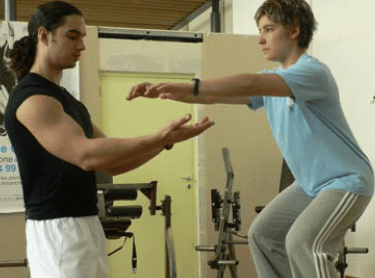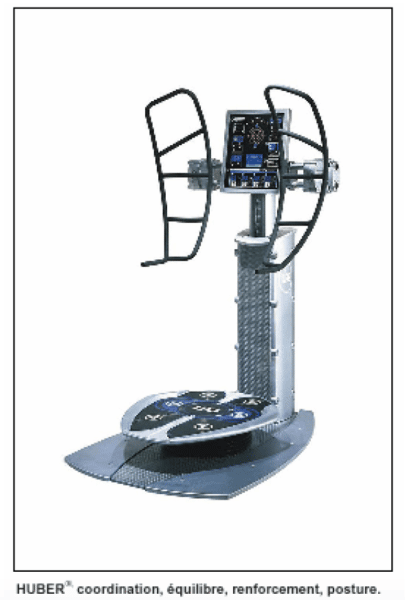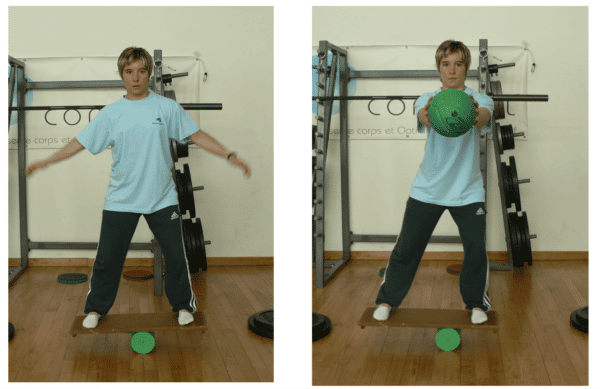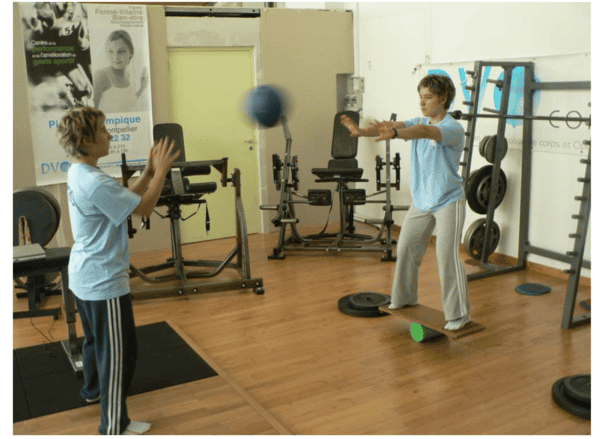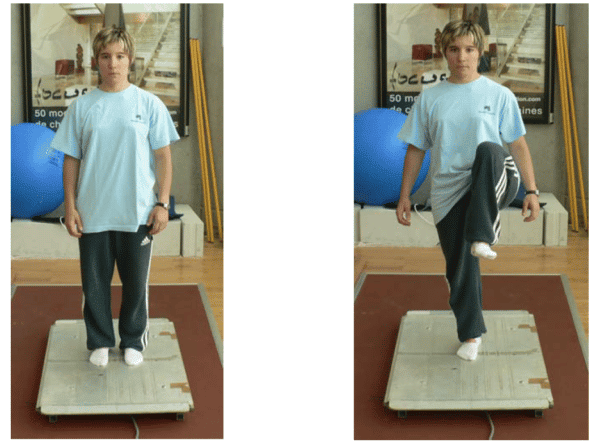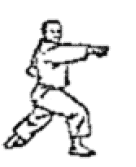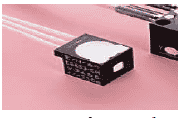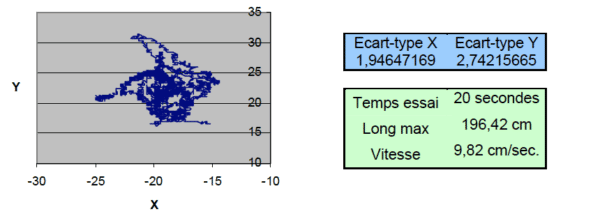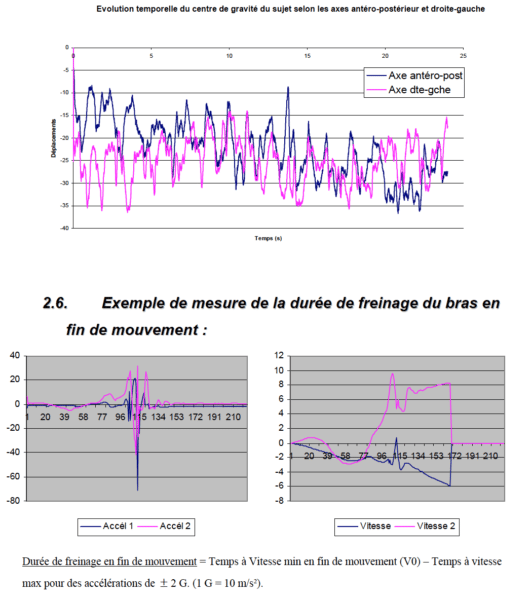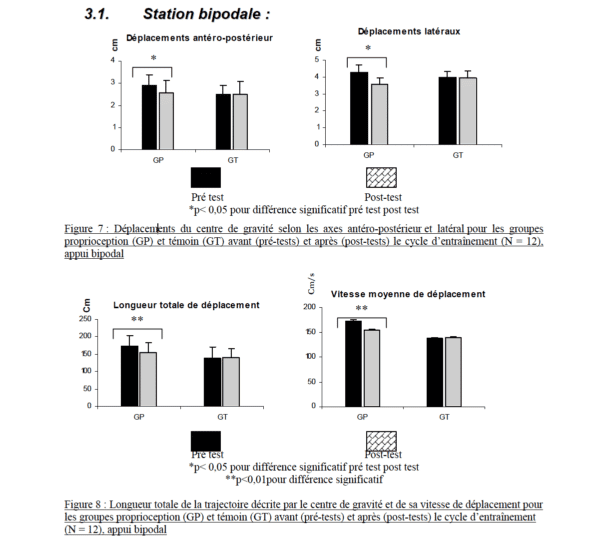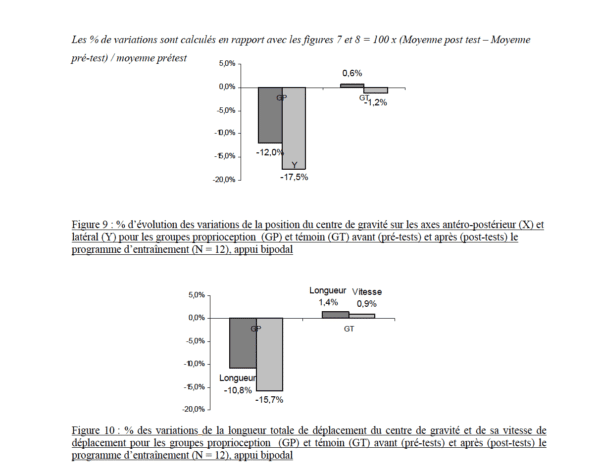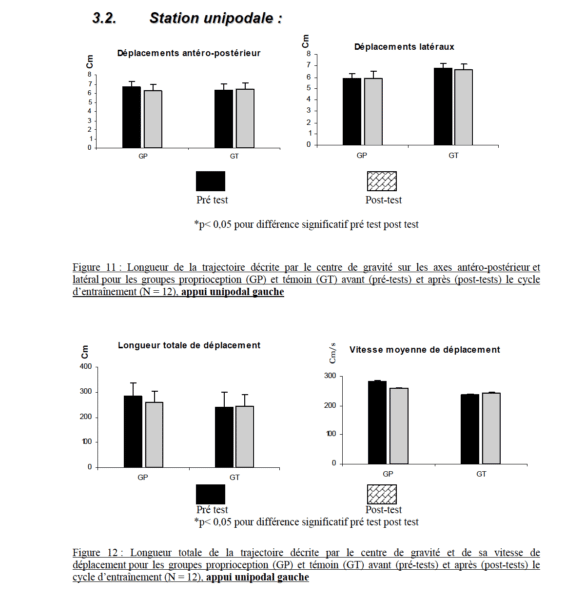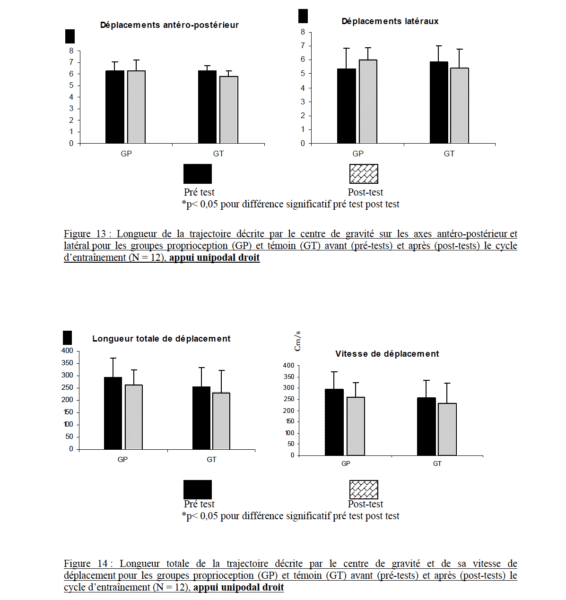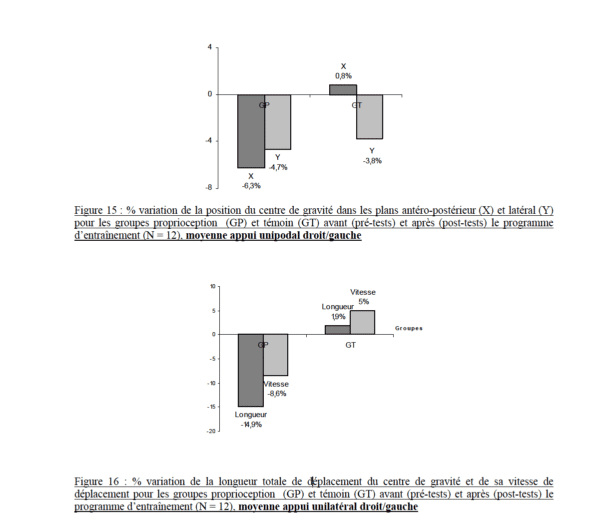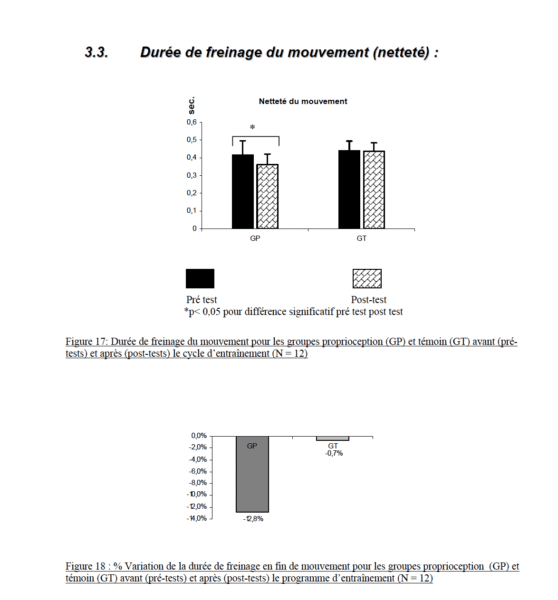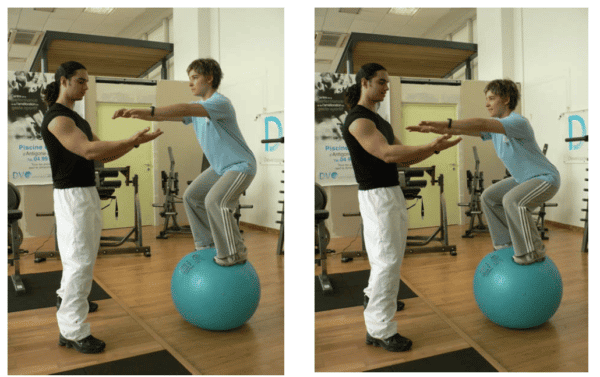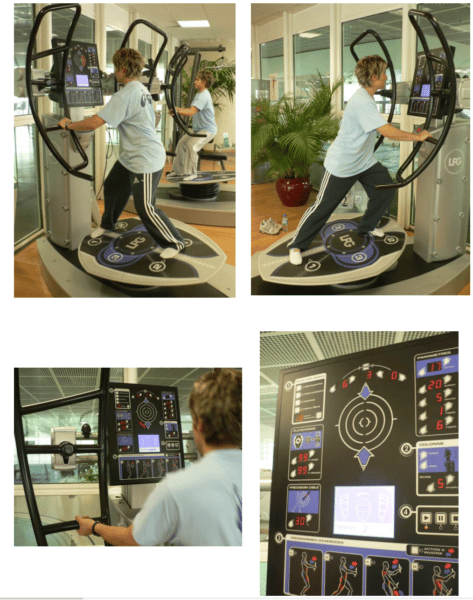PROPRIOCEPTION ON BALANCE IN HIGH LEVEL KARATEKA
During my studies, I wrote a thesis on the proprioception with a French champion in team kata, in order to obtain my Master 2 degree.
It is a very complex study that focuses on the receptors in the small muscles of the body that manage balance,
I share it with you.
UNIVERSITY OF MONTPELLIER I
Training and Research Unit
In Sciences and Techniques of Physical and Sports Activities
Thesis presented for the Master 2 Professional Human Movement Sciences
Specialty Engineering of Ergonomics of Physical and Sports Activities
Course PERFORMANCE ENGINEERING
Option PHYSICAL TRAINING
EFFECTS OF A SPECIFIC PROPRIOCEPTION TRAINING PROGRAM ON BALANCE IN HIGH LEVEL KARATEKA
Presented by Julien QUAGLIERINI,
Under the direction of : Ludovic MARIN Jean-Paul MICALLEF
Academic year 2005-2006
Acknowledgements
I would like to thank my thesis supervisor Mr. Ludovic Marin (MCU) for his precious help in the theoretical aspects of this project.
Thank you to my co-supervisor Mr. Jean Paul Micallef, Director of Research INSERM, for providing the equipment and all the time he devoted to this project. Jean Paul Micallef, Director of Research INSERM, for the provision of the material and all the time he devoted to the realization of this project.
Thanks to Mr. Sébastien Racinais for helping me with the statistical analysis of the results. Thanks to DVO concept for providing the LPG HUBER® equipment.
Thank you to all the athletes of the French Karate Centre who participated in this study and played the game to the end.
SUMMARY
1. INTRODUCTION
- 1.1. Karate
- 1.2 A particular form of sporting competition: kata
- 1.3. The specific physical preparation for kata
- 1.4. The notion of balance1.4.1 Neurophysiological basis of postural control
1.4.2. Improvement of balance through proprioception
1.5. Objectives of the brief
1.5.1. Issue
1.5.2. Purpose 1.5.3. Assumptions to be checked :
- METHOD AND MATERIALS USED
- 2.1. Topics
- 2.2. Training procedures
- 2.3. Measured parameters
- 2.4. Equipment, measuring device
- 2.5. Example of measurements of the evolution of the position of the centre of gravity in X Y
- 2.6. Example of measuring the braking time of the arm at the end of the movement
- 2.7. Statistical analysis
- RESULTS
- 3.1 Bipod station
- 3.2. Unipodal station
- 3.3. Movement braking time (sharpness)
- DISCUSSION
- 4.1. The bipodal station
- 4.2. The unipodal station
- 4.3. Movement braking time (sharpness)
- CONCLUSION AND OUTLOOK
- BIBLIOGRAPHY
- ANNEXES
1. INTRODUCTION
1.1. Karate
Karate, or the art of the empty hand, was born on the island of Okinawa. From the written traces, everything suggests that the origin of karate is Chinese and dates back to the 6th or 7th century: at that time, attacks by bandits and other troublemakers were frequent. To remedy this and to be able to defend themselves, the monks of the Shaolin temple (China) were helped by the Indian monk Bodhidharma who taught them the necessary fighting techniques. However, it seems very likely that this knowledge was not only passed on to the monks but also to the islanders, because when the Japanese invaded the island in the 17th century, they found peasants who had mastered the handling of weapons and unarmed combat techniques.
Over the years, karate was exported all over the world thanks to the JKA (Japan Karate Association) which launched a quest for the best karate practitioners in universities to train them and make them undisputed karate experts.
It is only in 1957, after the death of Master Funakoshi (founding father of Shotokan karate), that the first karate competitions will take place. France won its first world championship in 1972 and then created the FFKAMA (French Federation of Karate and Related Martial Arts) in 1975.
At present, there are four major schools of karate: Shotokan, Wadô-Ryu, Shito-Ryu and Gojo-Ryu.
1.2 A particular form of sporting competition: kata
This form of competition consists of two opponents successively performing a pre-established sequence of techniques, specific to each school or style of karate, in front of judges who decide who, in their opinion, is the best.
The practitioner will have to present a different kata at each round until the 5th after which he will be able to reproduce one of those previously performed.
1.3. The specific physical preparation for kata
The kata is characterized by techniques executed at maximum speed interspersed with short pauses or slower times of low intensity. The duration of the kata varies from one school to another.
The data concerning the practice of high level kata are rare.
Here, the main effects sought in physical preparation are the improvement of speed and power.
Overall, we can distinguish three types of movements:
- The slow movements and static positions whose execution cannot be done without a perfect postural balance, criterion of primordial judgement in kata.
- Explosive movements that start from a certain stationary position and stop abruptly in a specific, stabilized position.
Of course, to obtain a maximum speed, muscular adaptations are a main concern. But they are not the only ones, in fact, the braking at the end of the movement is a determining element: the later it is done and over a short period of time, the more we can hope that the speed achieved will be maintained over a longer period of time, or even reach a higher value. Thus, in order for the braking at the end of the movement to be late and over a short period, it is essential to be perfectly balanced.
- Movements with return to the initial position: The speed of most movements is based on the acceleration of the body or one of its segments from a stabilized position.
This is the very principle of explosiveness work, i.e. the ability to produce the highest possible force in the shortest possible time from the start of the movement.
Here, we can assume that the more stable the body position at the beginning of the movement, the greater the acceleration.
Moreover, the impression of "sharpness" of the movement (a primordial judging criterion in competition) will be all the more important as it will end with a brutal deceleration and a rapid stabilization of the body or the part of the body concerned.
Extracts from the judging criteria for the 2005-2006 season:
"Kata is not a dance or a theatrical performance. It must retain traditional values and principles. It must be realistic in terms of combat and show concentration, power and potential impact in the techniques. It must show stamina, power as well as speed, rhythm and balance. "
Thus, balance and stability are indeed determining notions in kata, bases from which the other physical qualities can be developed.
Indeed, the judging criteria impose :
a) The realistic demonstration of the meaning of the Kata.
b) The understanding of the techniques used (BUNKAI).
c) Good time, rhythm, speed, balance and power focus (KIME).
d) The proper and correct use of breath.
e) Proper focus of attention (CHAKUGAN) and concentration.
f) Correct positions (DACHI) with proper tension in the legs and feet flat on the floor.
g) The proper holding of the abdomen (HARA).
h) The correct form (KIHON) of the style presented. "
Here, the importance of the notion of balance in kata appears to be a determinant of performance.
1.4. The notion of equilibrium
Balance is "the generic term for the dynamics of body posture in fall prevention. It relates to the action of inertial forces on the body and the inertial characteristics of body segments" (Winter 1996).
The mechanisms underlying the control of movement and balance are complex because they involve a wide variety of structures in the nervous system.
We will then see that proprioception is one of the main means of developing balance.
1.4.1. Neurophysiological basis of postural control
The control of balance involves muscular effectors controlled by structures of the central nervous system, which are themselves connected to peripheral afferents, the whole constituting a highly automated regulatory system1.
The CNS structures involved in postural control are primarily the brainstem, cerebellum, basal ganglia and cerebral hemispheres in the supplementary motor area and right parietal lobe.
- The basal ganglia and brainstem are the regulatory centres for postural adjustments. They act in anticipation (feed forward) and in a feedback loop (feed back).
- The hemispheric structures play a privileged role in the body representation that sets the egocentric reference frame. - The cerebellum plays an important role in the regulation of movement at the level of muscle synergies. In recent years, its key role in the acquisition of movement has been emphasized.
The muscular effectors are distributed throughout the axial and peripheral musculature. To ensure the active part of postural control and balance, they must oppose the action of gravity on the superimposed limb segments. They thus exert these forces either passively by bringing their viscoelastic component into play, or actively by their mostly automatic recruitment.
The mechanisms involved in postural control and the management of imbalance are based on the coordinated and synergistic intervention of several perceptual systems that inform us at any time of our postures, react to the position of a muscle or to its length, and provide information on our position in space, on attitudes, on movements and on balance.
This is called the proprioception (concerns the deep sensibility, conveys the information captured at the level of proprioceptive receptors of the joints, tendons, ligaments, muscles, ensures the perception of postural sensations, information on oneself: they can consequently be visual as well as vestibular).
This is in contrast to external perception (collection of information on the external environment).
1 Massion, J. (1992). Movement, posture and equilibrium: Interaction and coordination. Progr. Neurobiol, 38, 35-56
Ligaments, muscles, ensures the perception of postural sensations, information about oneself: they can therefore be visual as well as vestibular).
This is in contrast to external perception (collection of information on the external environment).
Proprioception includes several perceptual systems:
- The musculo-tendino-articular system (the fastest) represents intelligence, i.e. an informative service with peripheral branching and sensors placed at the musculo-tendino-articular level.
These sensors are able to inform the spinal and brain stem centres at a very high speed. At the same time, this system is involved in the effector response. Indeed, the ability to finely modulate the muscular response depends on the neuromuscular spindles. The earliest postural reactions are activated by proprioceptive afferents and are deficient when these afferents are disturbed. This system therefore seems to have a place of primary importance in the realization of karate katas where the search for maximum speed, rhythm and balance are determinants of performance.
- The visual system (the most precise) also seems to be very important. Indeed, it represents a true pointing system that allows the body to "hook up" to fixation points while improving the precision of postural control. These two mechanisms work together and represent the precision system.
Finally, the vestibular system (the coarsest) is the latest mechanism to come into play, as it has a higher activation threshold. The greater latency of this system allows the "precision system" (musculotendino-articular + visual) to handle most postural situations in a more refined way. Thus, it represents an emergency response that outperforms the other two when head movements exceed a certain amplitude and speed.(2)
(2) Riva, D. (2003). Functional regression of postural control in high level athletes. Congress of the French Society of Sports Physiotherapists.
A subject can manage instability situations by using three main strategies: musculo-tendino-articular / visual (the most refined postural control, a constant characteristic of the great champions of sport, only the lower limb moves at high frequency to manage the instability situation), vestibular (much more imprecise, higher latency, counter-movements of the trunk, hips and upper limbs always excessive in relation to the biomechanical situation to be managed) with arm compensation (almost immobile trunk with use of the arms as a rudder, used in the presence of an inadequate proprioceptive strategy, to stabilize the system and limit vestibular intervention)(3).
Numerous studies show that a decrease in the involvement of the musculo-tendino-articular/visual system can cause functional regression and can force the subject to choose increasingly simplified movements, favouring vestibular strategies that contribute to increasing regression*.
They show that it is important to maintain postural mechanisms at refined levels especially in high performance athletes.
1.4.2. Improving balance through proprioception :
Numerous studies show the importance of proprioceptive work for improving posture and balance.
For example, performing muscle exercises on unstable surfaces (Swiss balls, unstable boards) stimulates the nervous system more than traditional resistance training methods. The advantage of this type of training lies in the neural adaptations that accompany it. For example, squats on unstable surfaces appear to provide a training stimulus for the muscles of the trunk that support the spine (erector spinae) and for the muscles that contribute to posture maintenance.(4) Thus, this data will prove to be essential for the development of balance in karatekas.
(3) Riva, D., Soardo, GP. (1999). Per ritrovare l'equilibrio. Sport & Medicina 5, 55-58 Riva, D., Archeopropriocezione. Sport & Medicina 2, 49-55, 2000.
(4) Anderson, K. Behm, D.G. (2005). Trunk muscle activity increases with unstable squat movements. Can J Appl Physiol, 30 (1), 33-45.
The specific neural adaptation that occurs with training does not increase the recruitment or activation of motor units, but improves the coordination of agonist and antagonist muscles (including stabilizing muscles). In recent years, researchers have used surface electromyography to measure muscle activity during exercise. However, very few studies have examined the effect of unstable surface strength training exercises on muscle activation and strength.
In this study, the researchers present the differences in electromyographic recording of the soleus, vastus lateralis, biceps femoris, abdominal stabilizers, upper lumbar spine erector and lumbosacral spine erector muscles during squats performed under varying conditions of stability and resistance. They stated that as stability decreased, trunk muscle activity increased.
Fourteen young men (25.2 ± 6.2 years old; 175.3 ± 6.5 cm; 82.6 ± 9.7 kg) who were members of competitive teams (hockey, soccer, squash), with a resistance training background (average of 7.8 ± 6.4 years) and who participated in a strength training program with free weights, resistance machines and instability exercises participated in the study. Six of the subjects used Swiss balls for core endurance exercises (sit-ups).
Prior to data collection, subjects were given two weeks of familiarization sessions during which they performed squats on stable and unstable surfaces (instability discs) using only body weight for three sets of 10 repetitions on six occasions. All tests were performed in one session. Stability was modified during the squats: - very stable condition: squats on a Smith machine; - relatively stable condition: free squats; - unstable condition: squats with instability discs under the feet.
Three intensities were used: - no external resistance (body mass); - 29.5 kg (Smith machine bar weight); - 60 % of body mass.
Using a metronome, subjects followed a 1-1-1 movement pattern, i.e., one second to descend to a 90-degree knee bend, one second to transition down and one second to ascend. Subjects were allowed two minutes to pause between repetitions to reduce the effect of fatigue.
Anderson, K., Behm, D.G. (2005). The impact of instability resistance training on balance and stability. Sports Med, 35(1), 43-53.
The activity of the soleus, abdominal stabilizer, upper lumbar spine erector and lumbosacral spine erector muscles (measured with surface electrodes) was significantly higher in the unstable condition (instability discs) and lower in the stable condition (Smith apparatus), at p < 0.005. In addition, electromyographic activity was higher during descent than during ascent. The increased electromyographic activity of these muscles is probably due to their postural and stabilizing role.
Squats on unstable surfaces appear to provide a training stimulus for the core muscles that support the spine (erector spinae) and for the muscles that help maintain posture.
Thus, in view of all these studies, it appears that this type of exercise is decisive for improving stability.
However, we have shown above the primordial character of balance in kata performance, we then make the hypothesis that it is indispensable to include in the physical preparation program of our karatekas muscular squats on unstable surfaces to improve posture and balance in kata.
1.5. Objectives of the brief :
1.5.1. Issue:
Based on the recent development of new technological means such as accelerometers and force sensors, we will test the effects of a proprioception work cycle on kata balance in order to optimize the specific physical preparation program.
1.5.2. Purpose:
To express the effects of a specific training in proprioception thanks to the new
current technologies on kata performance.
(5) Anderson, K. Behm, D.G. (2005). Trunk muscle activity increases with unstable squat movements. Can J Appl Physiol, 30 (1), 33-45.
To specify the place of proprioception in the annual program of physical preparation of karatekas.
1.5.3. Assumptions to be checked :
Violan et al (1997) (6) showed that karate practice significantly improved balance in proportion to the athletes' level of expertise. Results from similar studies also show improvements in flexibility, strength and balance. (7)
On the other hand, the results of numerous studies show that Tai Chi practice significantly improves balance (8) and postural control. (T'ai Chi practice leads to a greater use of the elasticity of peripheral structures involving muscles, ligaments and tendons while the participation of central neutral structures in postural balance is decreased). (9)
Thus, the practice of Tai Chi for more than 1 year could be beneficial at the level of the tendons and the reflex reaction of the gastrocnemius and would improve proprioception in particular at the level of the knee and ankle joint. These changes would be associated with a permanent improvement in dynamic balance. (10)
Tai chi chuan is a martial art that mainly involves methods of breath control and gestures. The techniques of tai chi chuan, inspired by the martial arts created in the Shaolin-si monastery, are based on flexibility and "internal strength" (neijia). The practitioner fights against an imaginary opponent, hence the nickname "boxing of the void" or "boxing of the shadows". It is in this that Tai Chi is very similar to kata in karate. The big difference lies in the movements described as explosive, starting from a determined immobile position and stopping abruptly in a precise position (speed and explosiveness factors).
(6) Violan et al, (1997). Improved balance in novice and elite karate participants
(7) Violan, MA, Small, EW, Zetaruk, MN, Micheli, LJ. (1997). The effect of karate training on flexibility. muscle strength. and balance in 8 to 13-year-old boys. Pediatr Exerc Sci; 9:55-64.
(8) Hain, T.C., Fuller, L., Weil, L., Kotsias, J. (1999). Effects of T'ai Chi on balance. Arch Otolaryngol Head Neck Surg, 125 (11), 1191-5.
(9) Forrest, WR. (1997). Anticipatory postural adjustment and T'ai Chi Ch'uan. Biomed Sci Instr, 33, 65-70.
(10) Fong, S.M., Ng, G.Y. (2006). The effects on sensorimotor performance and balance with Tai Chi training. Arch Phys Med Rehabil. Jan ; 87(1):82-7.
Consequently we make the hypothesis that the practice of kata in karate would improve, just like Tai chi, the qualities of balance, qualities of which we have previously shown the determining character of the performance in this activity.
The fact of programming a specific work cycle in proprioception (with in particular the use of squats on unstable surfaces) would thus make it possible to improve balance, qualities essential to the kata and consequently the performance in a shorter time.
2. METHOD AND MATERIALS USED 2. METHOD AND MATERIALS USED
2.1. Topics
This study was conducted on 12 karatekas from the French karate centre. They were divided into 2
groups (n= 6) randomly (1 proprioception group and 1 control group). Anthropometric characteristics of subjects (GP = proprioception group, GT = control group):
Control Group (CG)
In this control group, there will be no specific proprioception work. They will continue the classic technical training as well as the physical preparation with the other group.
Proprioception Group (PG)
This group underwent a specific proprioception training cycle for 6 weeks.
These trainings are done twice a week in addition to the daily technical trainings. 1 training session per week on the HUBER (20 min) + 1 classic proprioception training session (squats on unstable surfaces, Freeman's plate) integrated into the weekly physical preparation session.
2.2. Training procedures :
The protocol of the experiment lasted 6 weeks. Both groups were evaluated twice, once at the beginning and once at the end of the training cycle.
1st training of the week :
HUBER® :
J.M. Ferret, doctor of the French football team that won the World Cup in 1998 and
of Europe in 2000.
A study conducted in Lyon by Dr. J.M.
Ferret, showed the impact of training with the HUBER ® system on subjects of different sex, age and sporting activity. Depending on these factors, it was possible to measure the progression of the subjects in coordination and strengthening of the muscle chains after 8 weeks of training with the HUBER ®.
The results of these studies show that Huber®, thanks to a global and coordinated musculoskeletal activity, contributes to maintain the qualities
It is a visco-elastic system for the muscular and articular chains essential for a good posture. It consists of an oscillating plate, handles with sensors connected to an integrated computer allowing to exert and dose forces with precision.
From a starting evaluation, establishing a coordination score, and after a typical warm-up, the choice of program is displayed, from the simplest to the most elaborate, as well as free combinations (free level). In the free menu, you can choose the duration of the action time (force exerted by the upper limbs), the number of repetitions and series, the recovery time, the speed and amplitude of the plate's oscillation, and the movement of the spine (Scan).
The manual efforts, the choice of the position of the body, are so many factors which combined between them, make it possible to work out a multitude of exercises soliciting the deep muscles of the spinal column in particular, essential to balance, coordination, sheathing.
Christine Arron, Fabrice Tiozzo and many other top athletes (Carole Montillet, Richard Virenque, JC Lafaille, David Garrel) have already integrated HUBER into their physical preparation: (The ultimate use for Fabrice Tiozzo was the unipodal supports, centred, eccentric... Especially in boxing, there are many problems with draughts, blows that are not really in balance. Be able to go and find a balance or return as quickly as possible to a balance that may be momentarily compromised, it is essential. With HUBER this kind of exercise was extremely useful and effective). F.T
2nd weekly session:
During their weekly physical preparation session, during the recovery phases, we integrated specific proprioception exercises (with Swiss ball, Freeman tray, trampoline) by choosing forms and durations of exercises that did not generate additional energy expenditure so as not to disturb their session. Then, at the end of their physical preparation session, we carried out specific exercises requiring more attention and coordination (squats on an unstable surface, on a Swiss ball, with a Medicine Ball throw to increase the difficulty).
Figure 1: Balance on an unstable board Figure 2: Balance with a medicine ball
Figure 3: Balance with medicine ball throw (Jessica and Sabrina BUIL, four-time world champion, five-time European Kata champion)
2.3. Measured parameters :
Two types of measurements were taken before (pre-tests) and after (post-tests) the specific proprioception training program:
We measured:
- Bipodal and unipodal station on force platform: the determination of the evolution of the position of the projection of the centre of gravity in the sustentation polygon allows us to account for the state of equilibrium of the athlete.
- Triaxial accelerations: To measure the sudden stop of an explosive movement in a precise position. In kata, these are movements performed at maximum speed followed by a braking at the end of the movement. Thus, the later the braking and over a short period of time, the more one will obtain a rapid stabilization of the body or the part of the body concerned, i.e. the effect of neatness, cleanliness of the movement sought in kata.
2.4. Materials, measuring device: Instrumental evaluation of posture and balance :
The concepts of balance control and the instrumental measurement of balance parameters have developed from the use of force platforms whose design has evolved over time.
The increasing complexity of the systems, if it moves the instrumental evaluation away from the sphere of exploration accessible in everyday life, has allowed us to better specify the characteristics of balance in terms of reactions, referential and balancing strategies.
Static posturography
Force platforms consist of a rigid plate of variable size supported by several transducers that convert the applied force into an electrical signal. By measuring the forces and moments exerted on the platform, the coordinates of the centre of pressure can be deduced and its variations over time can be followed. The simultaneous recording of the variations of the centre of gravity and the variations of the centre of pressure shows variations of higher amplitude and frequency at the level of the latter. It is assumed that under conditions of quasi-static equilibrium (low frequency oscillations), the variations of the centre of pressure are correlated with those of the centre of gravity. In other situations of instability, stabilometry only analyses the variations of the centre of pressure which are no longer representative of the variations of the centre of gravity.
Posture and balance involve a large part of the axial and peripheral muscles and call for a complex regulation of the nervous system.
Test 1
Study of the displacement of the centres of pressure of a standing subject. To do this, the subject is placed on a force platform which records the projection of the centres of pressure on the ground at each moment. These parameters give us information on the regulation of the position of the centre of gravity. We thus obtain a statokinesigram. The use of a force platform requires, for the study of the static balance, a standardization of the parameters which ensures the reproducibility of the examination. The study of balance in the standing position with the eyes open
requires stabilization of the gaze on a target commonly placed between 90 cm and 2 meters, which corresponds to the distance of ocular rest. The acquisition time is about 20 seconds with bipodal support, shorter with unipodal support (10 to 15 seconds)
Figure 4: Bipodal support Figure 5: Unipodal support (left then right)
Computer processing of the data on the displacement of the centre of pressure makes it possible to specify the changes in the displacement of the subject's centre of gravity in the anteroposterior and lateral axes, as well as the total length of the trajectory described by the centre of gravity and its average speed of displacement.

Test 2
Sensors (force platform)
Acquisition card
USB communication
Computer
Consists of a triaxial accelerometer measurement chain. The electrical signals from these sensors are amplified and digitized to be recorded on a computer.
The measurement chain includes sensors (tri-axial accelerometers), amplifiers, a digital analog acquisition card and a portable PC.
The triaxial accelerometers are placed at the level of the striking fist. A cable connects it to a chain of amplifiers and an acquisition card
located at a distance from the subject. The cable does not interfere with the athlete's movements. The movement performed by
The athlete's move is a typical kata move performed at maximum speed. It
This is an oi tsuki shudan (punch while advancing median level).
Figure 6: Triaxial accelerometers (can measure accelerations simultaneously in 3 different directions)
The acquisition system consists of an analog-to-digital conversion box
with 4 measurement channels. It connects directly to the USB port of a laptop.
Labjack U12 Card Features 4 differential 12-bit analog inputs
± 10 Volts Maximum; Gains of 1, 2, 4, 5, 8, 10, 16 or 20 V/V; 1.2 kEch/Second; USB 2.0/1.1
2.5. Example of measurements of the evolution of the position of the centre of gravity in X Y :
The standard deviation measures the deviation from the observed mean and is the root mean square of the deviations between the observed values and the mean of these observed values
Standard deviation X = Standard deviation of the trajectory described by the centre of gravity on the antero-posterior axis
Standard deviation Y = Standard deviation of the trajectory described by the centre of gravity on the lateral axis
The trial period has been set at 20 seconds.
Maximum length (length of the "spaghetti") = Initial length + √ (X2-X1)2 + (Y2-Y1)2
Speed = Max Length / Test Time
Standard deviation X Standard deviation Y 1.94647169 2.74215665
The values found in the study are larger than those found in conventional studies because the sampling frequency is 250 Hz while it is 40 Hz in the literature.
2.7. Statistical analysis
After checking the homogeneity and normality of the data for each group, the effect of training was tested with a two-way RM ANOVA [group (GP, GT) x Measure (pretest, posttest)] with repeated measures on the second factor. The level of significance was set p < 0.05 (Sigma Stat, Jandel Corporation, CA).
3. RESULTS
3.1 Bipod station :
The % of variations are calculated in relation to figures 7 and 8 = 100 x (Post-test mean - Pre-test mean) / Pre-test mean
Comparing the results obtained on the training protocols (GP, GT) and between the pre and post test, we can see that:
The GP proprioception group significantly decreased anteroposterior and lateral bipodal oscillations of the center of gravity by 12% and 17.5% respectively (F(1,10) = 6.886, p<0.05).
The total length as well as the speed of the displacement of the center of gravity over the entire test duration (20 sec.) significantly decreased by 10.8% (F(1,10) =10.248, p<0.05) and 15.7% (F(1,10) = 17.062, p<0.05).
The GP control group increased the anteroposterior and lateral sway of the center of gravity by 0.6 % and decreased by 1.2% (ns), respectively.
The total length as well as the speed of the displacement of the center of gravity over the entire test duration (20 sec.) increased by 1.4% and 0.9% (ns).
Comparing the results obtained on the training protocols (GP, GT) and between the pre and post test, averaged over the left and right supports, we can see that: The GP proprioception group decreased the unipodal antero-posterior and lateral oscillations of the centre of gravity by 6.3% and 4.7% respectively. (ns)
The total length as well as the velocity of the displacement of the center of gravity over the entire test period decreased by 14.9% and 8.6%. (ns)
The GP control group increased the anteroposterior and lateral sway of the center of gravity by 0.8% and decreased by 3.8%. (ns)
The total length as well as the velocity of the displacement of the center of gravity over the entire test period increased by 1.9% and 5%. (ns)
Comparing the results obtained on the training protocols (GP, GT) and between the pre and post test, we can see that:
The GP proprioception group significantly decreased the duration of torso braking at the end of the movement by 12.8% (F(1,10) = 4.973, p<0.05).
The GP control group decreased very slightly the braking time of the studied segment at the end of the movement by 0.7% (ns).
4. DISCUSSION 4. DISCUSSION
4.1. The bipodal station
In view of all our results, it would seem that proprioception training (HUBER® + squats on unstable surfaces) significantly improves the stability of the centre of gravity in the bipodal position. These results are in agreement with those of Anderson and Behm (2005).
Indeed, this cycle of work has certainly allowed to strengthen the muscles of the trunk that support the spine (spinal erector), the muscles that contribute to the maintenance of the posture as well as an improvement of the coordination of the agonist and antagonist muscles.
We can hypothesize that there were beneficial effects at the level of the tendons and the reflex reaction of the gastrocnemius as well as an improvement in proprioception, in particular at the level of the knee joint and the ankle, thus allowing for a reduction in the oscillations of the position of the centre of gravity and consequently allowing for more precise control of the bipodal balance.
The GT control group, which only practiced traditional technical-tactical sessions, experienced a slight increase in the oscillations of the centre of gravity (displacement, total length, speed), which therefore translates into a slight deterioration in bipodal balance, which is in line with the results of Riva's (2003) studies on the Functional regression of postural control in high level athletes.
Indeed, the practice of Kata requires a very refined postural strategy and without an appropriate balance stimulation, all the systems involved in the postural control can present a functional regression. Thus, it can happen that the hyperstimulation of certain systems (nervous system: speed, explosiveness in particular) causes the regression of less committed systems.
A decrease in the proprioceptive-visual system can then cause functional regression and may force the subject to choose increasingly simplified movements, favouring vestibular strategies that contribute to increasing regression.
This regression would be a consequence of the non-use or inadequate stimulation of the postural systems involved.
Thus, it seems quite interesting and even essential to integrate proprioception exercises such as we have presented, in the physical preparation sessions of karatekas in order to improve more quickly the stability and thus the performance in kata.
4.2. The unipodal station
Although the results show a slight improvement in unipodal stability in the proprioception group, the statistical analyses do not show a significant training effect.
This could be due to the fact that the training proposed during this proprioception cycle was essentially based on bipodal support exercises.
Moreover, it would seem that a 6-week cycle is not sufficient to significantly improve unipodal stability, which requires a larger part of the musculature and a more elaborate, more complex neural adaptation.
In fact, quasi-static balance in bipodal support only calls upon part of the complex system that ensures balance, unlike unipodal support. Some studies have shown that the labyrinthine afferents are only stimulated beyond a certain amplitude of oscillations. (12)
We can therefore make the hypothesis that to improve unipodal stability, it is advisable to carry out specific proprioception work cycles by integrating more exercises in unipodal support, for a longer duration than our protocol in order to train labyrinthine adaptation in particular.
4.3. Movement braking time (sharpness)
The results we obtained allow us to state that 6 weeks
specific proprioception training (HUBER®, squats on unstable surfaces) at a rate of two training sessions per week are sufficient to significantly improve the impression of "sharpness" of the movement by a sudden deceleration and a rapid stabilisation of the body or the part of the body concerned.
(11) Riva, D. (2003). Functional regression of postural control in high level athletes. Congress of the French Society of Sports Physiotherapists.
(12) Amblard B. Descriptors of postural control. Ann. Rehabilitation Méd. Phys. 1998, 41, 225-237
This would seem to be the consequence of a strengthening of the soleus muscles, stabilizers of the abdomen, erectors of the upper lumbar spine and erectors of the lumbosacral spine. Thus, the subject, starting from a more stable immobile position, will be able to trigger his explosive movement and stop suddenly in a much more precise, stabilized position. This will allow him to slow down his movement in a shorter time, which will give an impression of sharpness of the gesture.
Here, the concerned part that we analyzed is the fist because the stabilization of this one in kata is major for an impression of sharpness. However we could have also placed an accelerometer at the level of the foot and the hip in order to obtain more precise data but the measuring device remains cumbersome.
5. CONCLUSION AND OUTLOOK 5. CONCLUSION AND PERSPECTIVE
The main purpose of our study was:
- To express the effects of a specific training in proprioception thanks to the current new technologies on the performance in kata.
- To specify the place of proprioception in the annual physical preparation program of karatekas.
Thanks to the use of recent technological means such as accelerometers and force sensors, we were able to set up specific tests for kata activity, one of the two forms of karate competition. These tests were carried out to evaluate the effects of a proprioception work cycle on kata balance in order to optimize the specific physical preparation program:
- the beneficial effects of a specific work cycle in proprioception (with in particular the use of squats on unstable surfaces and HUBER®) on bipodal balance, on the stability and the sharpness of the technical gesture, qualities essential to kata and consequently to performance.
- A slight degradation of balance qualities at the end of a traditional training programme without recourse to specific proprioceptive work.
If France has succeeded in imposing itself for several years on the first steps of the international podium in karate despite the increasingly demanding level, it is partly thanks to the progressive integration of physical preparation in the planning of karatekas. Indeed, at high level the technical-tactical degree is more or less the same.
However, if physical preparation has been able to impose its place in the annual planning of fighters by overcoming prejudices (negative effects on the quality and the efficiency of the strike in particular), that of kata competitors remains more discreet.
However, if we study carefully the qualities that are indispensable for kata performance, besides the qualities of explosiveness, the stability of the body and the impression of "neatness" of the movement are primordial criteria of performance.
The limitations of this study are the relatively small number of athletes tested, the rather expensive HUBER® equipment, the size of the measurement system and the presence of wires between the subject and the recording device (test with accelerometers).
Our work has shown that proprioception work with squats on unstable surfaces as well as on the HUBER® has become a fundamental component of physical preparation for kata.
It appears necessary in the annual programming to introduce proprioception sessions such as we have proposed in the physical preparation sessions.
This type of work should also be an integral part of the physical preparation of fighters, other combat sports (boxing, taekwondo), activities where balance is a determining factor in performance (skiing, snowboarding, surfing, windsurfing ...) but also to strengthen the deep muscles, sheathing and prevent injuries.
Moreover, if HUBER® was associated in our experimentation with the use of exercises based on the realization of squats on unstable surfaces, it is first of all with an aim of complementarity but also with a concern of organization.
Indeed, we rarely have to deal with a single athlete in physical preparation, even in a physiotherapy practice.
Thus, the use of several forms of complementary work is essential in order to manage the factors of organization and performance as well as possible.
6. BIBLIOGRAPHY
Allum, J.H., Bloem, B.R., Carpenter, M.G., Hulliger, M., Hadders-Algra, M., (1998). Proprioceptive control of posture: a review of new concepts. Gait and Posture 8(3): 214- 242.
Amblard, B., (1998). Descriptors of postural control. Ann. Rehabilitation Phys. 41, 225-237
Anderson, K., Behm, D.G. (2005). The impact of instability resistance training on balance and stability. Sports Med, 35(1), 43-53.
Anderson, K. Behm, D.G. (2005). Trunk muscle activity increases with unstable squat movements. Can J Appl Physiol, 30 (1), 33-45.
Behm, D. et al. (2002). Muscle force and neuromuscular activation under stable and unstable conditions. J Strength Cond Res, 9, 264-274.
Fong, S.M., Ng, G.Y. (2006). The effects on sensorimotor performance and balance with Tai Chi training. Arch Phys Med Rehabil. Jan ; 87(1):82-7.
Forrest, WR. (1997). Anticipatory postural adjustment and T'ai Chi Ch'uan. Biomed Sci Instrum, 33, 65-70.
Fourré, M. (2003). Le karaté, préparation physique et performance. Collection Entraînement. Paris : INSEP publication, 175 pages.
Hain, T.C., Fuller, L., Weil, L., Kotsias, J. (1999). Effects of T'ai Chi on balance. Arch Otolaryngol Head Neck Surg, 125 (11), 1191-5.
Ivanenko, Y.P., Levik, Y.S., Talis, V.L., Gurfinkel, V.S., (1997). Human equilibrium on unstable support: the importance of feet-support interaction. Neuroscience Letters 235(3): 109-12.
Lacouture, P., JUNQUA, A. (2000). Theory and methodology of mechanical analysis in combat sports. In: Terrisse, A. Recherches en Sports de combat et en Arts martiaux. Paris: Edition revue EPS, 215-230.
Björklund, M. (2004). Effects of repetitive work on proprioception and of stretching on sensory mechanisms: Implications for work-related neuromuscular disorders, http://urn.kb.se/resolve?urn=urn:nbn:se:umu:diva-211 (2006-04-13)
Massion, J. (1992). Movement, posture and equilibrium: Interaction and coordination. Progr. Neurobiol, 38, 35-56
Nichols, DS. (1997). Balance retraining after stroke using force platform biofeedback. Phys Ther, 77 (5), 553-8.
Thoumie P., Mevellec, E. (2001). Physiology of balance, La chute, N° 59
Reifel Saltzberg, J., Hondzinski, J.M., Flanders, M. (2001). Humans adapt the initial posture in learning a whole-body kicking movement. Neurosci Lett, 306(1-2), 73-6.
Riva, D. (2003). Functional regression of postural control in high level athletes. Congress of the French Society of Sports Physiotherapists.
Riva, D., Soardo, GP. (1999). Per ritrovare l'equilibrio. Sport & Medicina 5, 55-58
Riva, D.,(2000). Archeopropriocezione. Sport & Medicina 2, 49-55
Violan et al, (1997). Improved balance in novice and elite karate participants
Violan, MA, Small, EW, Zetaruk, MN, Micheli, LJ. (1997). The effect of karate training on flexibility. muscle strength. and balance in 8 to 13-year-old boys. Pediatr Exerc Sci; 9:55-64.
Wayne, P.M., Krebs, D.E., Wolf, S.L., Gill-Body, K.M., Scarborough, D.M., McGibbon, C.A., Kaptchuk, T.J., Parker, S.W. (2004). Can Tai Chi improve vestibulopathic postural control, Arch Phys Med Rehabil; 85(1):142-52.
7. ANNEXES
Squat on Swiss ball :
Training on HUBER® :
Summary:
The aim of our work was to express the effects of a specific training in proprioception thanks to the new current technologies on the performance in kata, and to specify the place of proprioception in the annual program of physical preparation of the karatekas.
12 karatekas of national level divided into 2 groups made up the population of this experiment: Proprioception group (n= 6): a 6-week proprioception work cycle including squats on unstable surfaces and the use of HUBER®; Control group (n= 6): a traditional karate practice
At the end of this program, the proprioception group recorded significant p<0.05 decreases in the oscillations of the position of the centre of gravity in bipodal position (antero-posterior and lateral) as well as on the total length and speed of movement. The control group showed slight significant increases in most of these parameters.
The working hypothesis that programming a specific work cycle in proprioception (with the use of squats on unstable surfaces and HUBER®) would improve balance, qualities essential to kata, and consequently performance in a shorter time is verified, since we obtained significant results in terms of improving bipodal balance and the sharpness of the movement at the end of the movement.
Keywords: proprioception, balance, Kata, HUBER®, squats on unstable surfaces
Abstract:
The purpose of our work was to express the effects of specific proprioception training thanks to the new current technologies on the kata performance and to clarify the place of the proprioception in the annual program of the karatekas physical preparation.
12 karatekas of national level shared in 2 groups composed the population of this experiment : Proprioception group (n = 6) : a working proprioception cycle of 6 weeks containing a work of squats on unstable surfaces and HUBER ®'s use ; Reference group (n = 6) : a traditional practice of the karate.
In the term of this program, the proprioception group have significant falls (p < 0,05) of the oscillations of the position of the gravity centre in bipodal position (antero-posterior} and laterals) as well as on the total length and the speed of the movement.
The reference group registered light significant increases of most of these parameters.
The working hypothesis according to which the fact of programming a specific proprioception cycle (with notably unstable squat movements and HUBER®) would allow to improve the balance, qualities indispensable to the Kata and consequently the performance in a shorter time, is verified, because we obtained significant results as for the improvement of the bipodal balance and from the neatness of the gesture at the end of movement.
Keywords: proprioception, balance, Kata, HUBER®, unstable squat movements
Additional articles to read:
What is the importance of bodyweight training?

